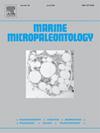Large-sized benthic foraminifera at the northern limit of subtropical zone: southern Kochi, Shikoku Island, Japan
IF 1.5
4区 地球科学
Q2 PALEONTOLOGY
引用次数: 0
Abstract
Large benthic foraminifera (LBF) are relatively large (>0.5 mm), symbiotic with microalgae, and can be found in tropical to subtropical, clear, shallow waters. LBF are commonly studied in lower latitudes but are less studied in higher latitudes close to their current limit of geographic distribution. As climate change progresses, poleward extension is expected to proceed apace, thus it is important to characterize benthic foraminiferal fauna in these higher latitude zones in order to track the progress of their habitat extensions. The present study examined large-sized (0.5 to 2 mm size fraction) benthic foraminifera, both symbiotic and non-symbiotic, in one such region: Kochi Prefecture in Shikoku Island, Japan. Living foraminifera attached to algae as well as in sediment, and dead foraminiferal tests in sediment were collected from three stations in the study area. A total of 64 taxa were identified, of which 17 were found living in algae, 8 living in sediment, and 60 were dead in sediment. Amphistegina lobifera was the dominant species in the region, making up almost 50 % of all specimens identified, followed by other symbiotic foraminifera. Compared to foraminiferal living communities and dead assemblages in lower latitudes (the Ryukyu Island Arc), amphisteginids and textulariids were more common in Kochi. Calcarinids which are dominant in the Ryukyu Island Arc were not found in this study.

亚热带北部边界的大型底栖有孔虫:日本四国岛高知南部
大型底栖有孔虫(LBF)相对较大(>0.5 mm),与微藻共生,可在热带至亚热带,清澈,浅水中发现。LBF通常在低纬度地区进行研究,但在接近其当前地理分布极限的高纬度地区研究较少。随着气候变化的进展,极向扩展预计将迅速进行,因此,为了跟踪其栖息地扩展的进展,对这些高纬度地区的底栖有孔虫动物群进行表征是重要的。本研究在日本四国岛的高知县调查了大型(0.5至2毫米大小的部分)底栖有孔虫,包括共生和非共生。在研究区三个站点收集了附着于藻类和沉积物中的活有孔虫,以及沉积物中的死有孔虫试验。共鉴定出64个分类群,其中17个生活在藻类中,8个生活在沉积物中,60个死于沉积物。该地区的优势种为大叶两栖虫,占所有鉴定标本的近50%,其次是其他共生有孔虫。与低纬度地区(琉球岛弧)的有孔虫生活群落和死亡群落相比,高知地区的amphisteginids和textulariids更为常见。本研究未发现琉球岛弧中占优势的Calcarinids。
本文章由计算机程序翻译,如有差异,请以英文原文为准。
求助全文
约1分钟内获得全文
求助全文
来源期刊

Marine Micropaleontology
地学-古生物学
CiteScore
3.70
自引率
15.80%
发文量
62
审稿时长
26.7 weeks
期刊介绍:
Marine Micropaleontology is an international journal publishing original, innovative and significant scientific papers in all fields related to marine microfossils, including ecology and paleoecology, biology and paleobiology, paleoceanography and paleoclimatology, environmental monitoring, taphonomy, evolution and molecular phylogeny. The journal strongly encourages the publication of articles in which marine microfossils and/or their chemical composition are used to solve fundamental geological, environmental and biological problems. However, it does not publish purely stratigraphic or taxonomic papers. In Marine Micropaleontology, a special section is dedicated to short papers on new methods and protocols using marine microfossils. We solicit special issues on hot topics in marine micropaleontology and review articles on timely subjects.
 求助内容:
求助内容: 应助结果提醒方式:
应助结果提醒方式:


